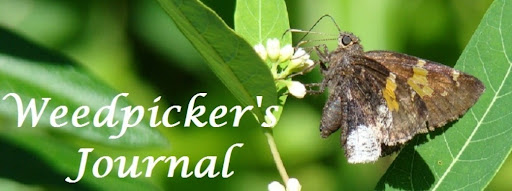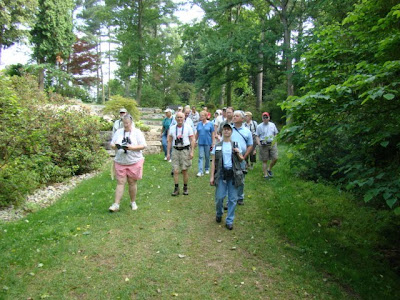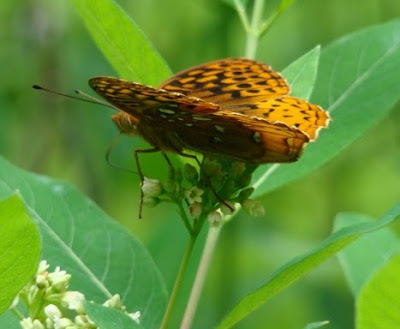Just as birders do a Christmas Bird Count, we butterfly folks have a 4th of July Butterfly count. So, this post is for all our butterfly friends getting geared up for this weekend.As stated in the last post, the Bobolinks and Butterfly Festival at Byers Woods was started in order to protect the bobolinks, but we enjoy promoting the diverse butterfly species too. Greater Mohican Audubon put in a butterfly garden at Byers Woods many years ago, and its native plants attract a crowd... both human and butterfly. American Snout .....photo by James SuchyIt's not too difficult to figure out how this flutter-by came by its name. This southern species migrates north (often from Texas) to lay eggs on it only Ohio host: Hackberry trees. Byers Woods has multiple Hackberries, and all three butterflies dependant upon that plant: American Snout, Hackberry and Tawny Emperor.
American Snout .....photo by James SuchyIt's not too difficult to figure out how this flutter-by came by its name. This southern species migrates north (often from Texas) to lay eggs on it only Ohio host: Hackberry trees. Byers Woods has multiple Hackberries, and all three butterflies dependant upon that plant: American Snout, Hackberry and Tawny Emperor. Milbert's Tortoiseshell..... photo by James SuchyJames Suchy sent along this beautiful photo of the Milbert's Tortoiseshell. Almost like magic, this brilliantly colored butterfly can "disappear" by closing its wings, and looking ever-so-much like a dead leaf. A wonderful bit of camouflage.
Milbert's Tortoiseshell..... photo by James SuchyJames Suchy sent along this beautiful photo of the Milbert's Tortoiseshell. Almost like magic, this brilliantly colored butterfly can "disappear" by closing its wings, and looking ever-so-much like a dead leaf. A wonderful bit of camouflage. Banded Hairstreak..... photo by James Suchy
Banded Hairstreak..... photo by James Suchy
Yes, this is the most common of the Hairstreaks and one must look closely to tell these species apart. But consider too, the lovely composition of this photo. Banded Hairstreak's host plants are Oaks and Hickories, it is often found nectaring on Common Milkweed, Asclepias syriaca.
Delaware Skipper..... photo by James Suchy
Those skippers are known for being drab and confusing, the sparrows of the lepidoptera species! However, this female Delaware is a stand-out with bright orange wings outlined in brown with a dark patch on the forward wing cell. Nectaring on the lovable prairie species-Purple Coneflower, Echinacea purpurea.
 Virginia Ctenuchid..... photo by Sue Evanoff
Virginia Ctenuchid..... photo by Sue Evanoff
A bit of a wolf in sheep's clothing, black-cloaked day flier may be confusing. It is the Virginia Ctenuchid (ten-new-kid) moth. Often found nectaring in the daytime, it is a rather common day flying moth. So not all moths fly at night... and not all lepidopteran day fliers are butterflies. Insects- they're full of surprises!
 American Snout .....photo by James Suchy
American Snout .....photo by James Suchy Milbert's Tortoiseshell..... photo by James Suchy
Milbert's Tortoiseshell..... photo by James Suchy





































 Always the
Always the 










